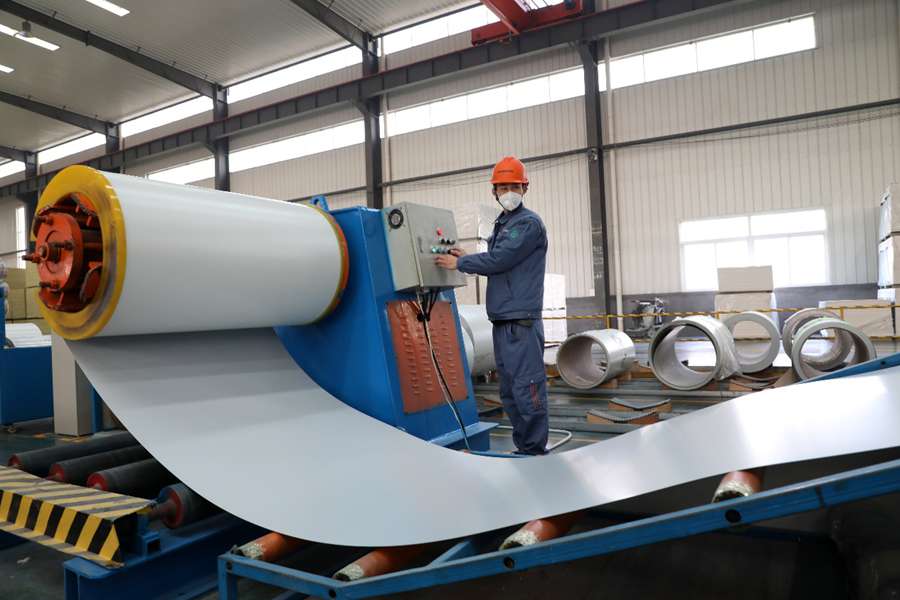

 |
| A worker produces sandwich panels at a workshop of Wiskind Group, a company engaged in steel building and trading in Binzhou, east China’s Shandong province, Feb. 9. Sandwich panel is a special construction material used for building structures that have extremely high requirements on indoor environment. (Photo by Chen Bin, People’s Daily Online) |
Wuhan, capital of central China’s Hubei province and epicenter of the novel coronavirus epidemic, is making all efforts to leave no patient unattended.
Since Feb. 9, the city started all-out efforts to locate “four categories of people” -- patients confirmed or suspected to be infected with the virus, their close contacts and patients with fever. Once identified, these people must be timely treated or placed in quarantine.
To guarantee strict prevention and control of the epidemic and cut the source of infection, Wuhan carried out a large-scale health examination for its citizens based on the principle of early discovery, diagnosis, quarantine and treatment.
As of Feb. 9, authorities have visited 10.59 million people from 4.21 million households in 3,371 communities and villages, or about 99% of the city’s population and 98.6% of all households.
By the noon of Monday, February 10, Wuhan authorities have discovered 1,499 patients in critical conditions through door-to-door health checks and sent them to hospital.
Hu Mingrong, chief of the Jiangxinyuan community in Wuhan’s Hanyang district has made around 400 phone calls to screen the residents on Feb. 9 alone. The 59-year-old woman who’s responsible for serving all 9,800 residents in the community, said the community discovered 15 confirmed cases and 26 patients with fever that day. The total number of the people falling into the "four categories” stood at 73, she added.
“We had screened all the people by the last afternoon, and we are doing a double-check today,” Hu noted.
Wuhan has also stepped up efforts to test all suspect cases. By 24:00 Feb. 9, there were 10,372 patients of the novel coronavirus receiving treatment at hospitals, including 3,082 in critical conditions and 838 in need of intensive care.
According to Hu Yabo, member of the standing Committee of the Wuhan Municipal Committee of the Communist Party of China and deputy mayor of Wuhan, the city now has over 8,800 beds in all of its 28 designated hospitals, and 2,600 beds in the Huoshenshan and Leishenshan Hospitals specially for those in critical conditions. There would be some additional 9,600 beds for patients with mild symptoms to be made available in the three already operational “fangcang” hospitals and other medical facilities renovated from schools.
By the night of Feb. 9, the three “fangcang” hospitals have received a total of 2,865 patients with mild symptoms, including 1,400 at the Wuhan International Exhibition and Convention Center in Jianghan district, 1,000 at Hongshan Gymnasium in Wuchang district and 465 at a cultural building complex dubbed “Wuhan Livingroom”.
The “fangcang” hospitals generally comprise of medically functional units, ward units and technical guarantee units, and have multi-functions such as emergency aid, surgery treatment and clinic diagnosis.
Wang Chen, vice president of the Chinese Academy of Engineering and president of the Chinese Academy of Medical Sciences noted that compared with small and closed quarantine wards, the “fangcang” hospitals are able to receive more patients, and the open wards can also improve the efficiency of caring, which allows doctors and nurses to take care of more patients. As the hospitals only receive diagnosed cases, cross-infection will not be a problem, Wang added.
Over 700 medical staff across the country went to Wuhan to assist the “fangcang” hospitals in recent days, most of whom are nurses.
After receiving training from Gao Yongzhe, associate chief physician of the department of neurology at Zhongnan Hospital of Wuhan University and Zhou Junhui, head nurse of the hospital, they started working in groups to guarantee smooth operation of the “fangcang” hospitals.
Every bed of the hospitals is equipped with power supply, an electric blanket, and a long coat to meet the basic demand of the patient. Besides, there are also books and TVs at the hospitals for publicity and psychological counselling.
“We keep close monitoring of every patient and offer psychological support through communication, so as to help them build confidence,” said Zhou. Though many of the medical staff are working day and night, and even don’t have the time for a cup of water, they never complain about it, and their only wish is to cure the patients as early as possible.
 |

 Award-winning photos show poverty reduction achievements in NE China's Jilin province
Award-winning photos show poverty reduction achievements in NE China's Jilin province People dance to greet advent of New Year in Ameiqituo Town, Guizhou
People dance to greet advent of New Year in Ameiqituo Town, Guizhou Fire brigade in Shanghai holds group wedding
Fire brigade in Shanghai holds group wedding Tourists enjoy ice sculptures in Datan Town, north China
Tourists enjoy ice sculptures in Datan Town, north China Sunset scenery of Dayan Pagoda in Xi'an
Sunset scenery of Dayan Pagoda in Xi'an Tourists have fun at scenic spot in Nanlong Town, NW China
Tourists have fun at scenic spot in Nanlong Town, NW China Harbin attracts tourists by making best use of ice in winter
Harbin attracts tourists by making best use of ice in winter In pics: FIS Alpine Ski Women's World Cup Slalom
In pics: FIS Alpine Ski Women's World Cup Slalom Black-necked cranes rest at reservoir in Lhunzhub County, Lhasa
Black-necked cranes rest at reservoir in Lhunzhub County, Lhasa China's FAST telescope will be available to foreign scientists in April
China's FAST telescope will be available to foreign scientists in April